Dissertation on Obesity in Children: Factors and Prevention
VerifiedAdded on 2023/06/07
|28
|10525
|392
Thesis and Dissertation
AI Summary
This dissertation investigates obesity in children, covering its background, aims, and objectives in the introductory chapter. The literature review presents different authors' perspectives on the key issues, followed by a discussion of research methodologies, including research type, approach, design, data collection, and ethical considerations. The dissertation also presents findings and discussions, concluding with recommendations and limitations of the research. It highlights the increasing prevalence of childhood obesity, influenced by factors like lack of physical activity, unhealthy eating habits, and genetic predispositions, and emphasizes the importance of understanding these factors for effective prevention.
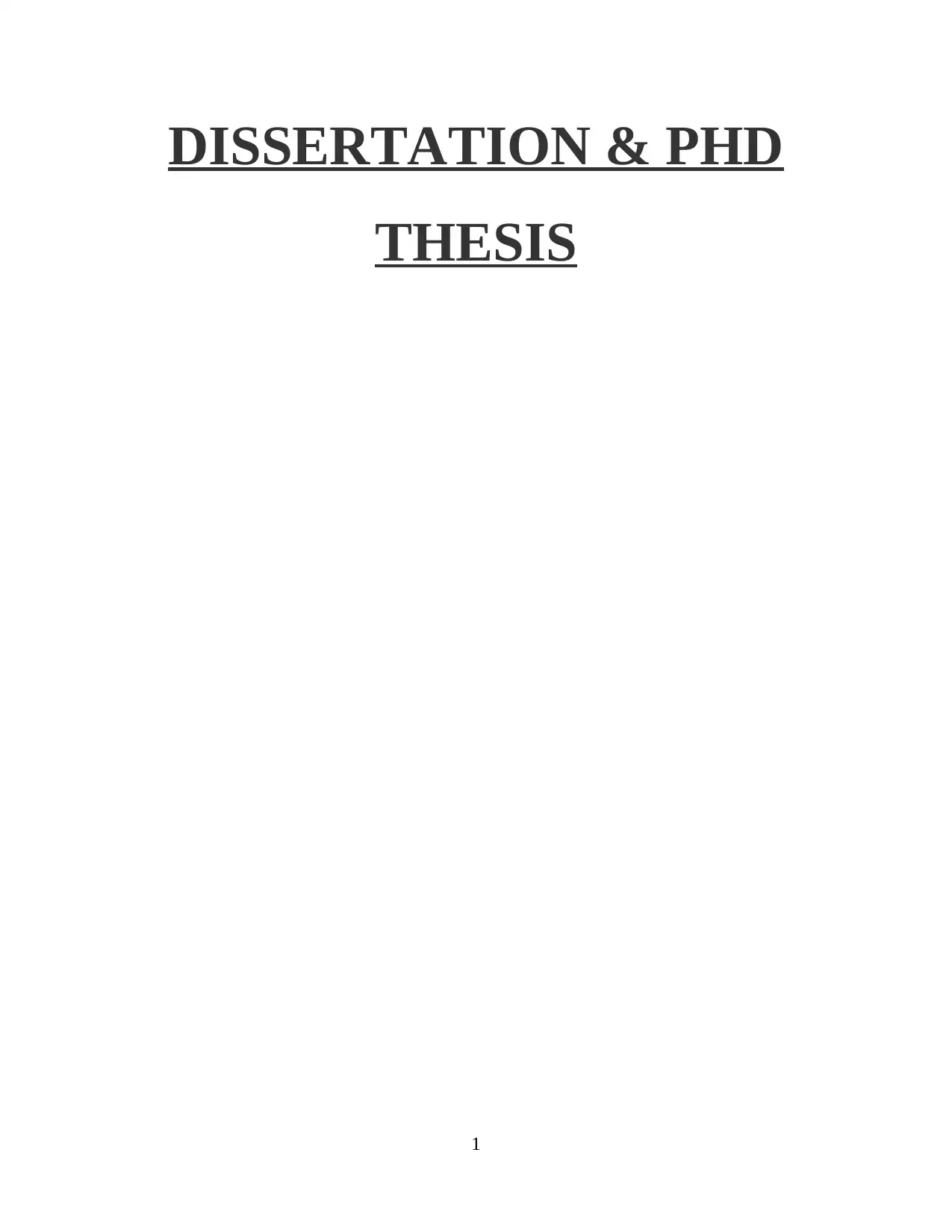
DISSERTATION & PHD
THESIS
1
THESIS
1
Paraphrase This Document
Need a fresh take? Get an instant paraphrase of this document with our AI Paraphraser
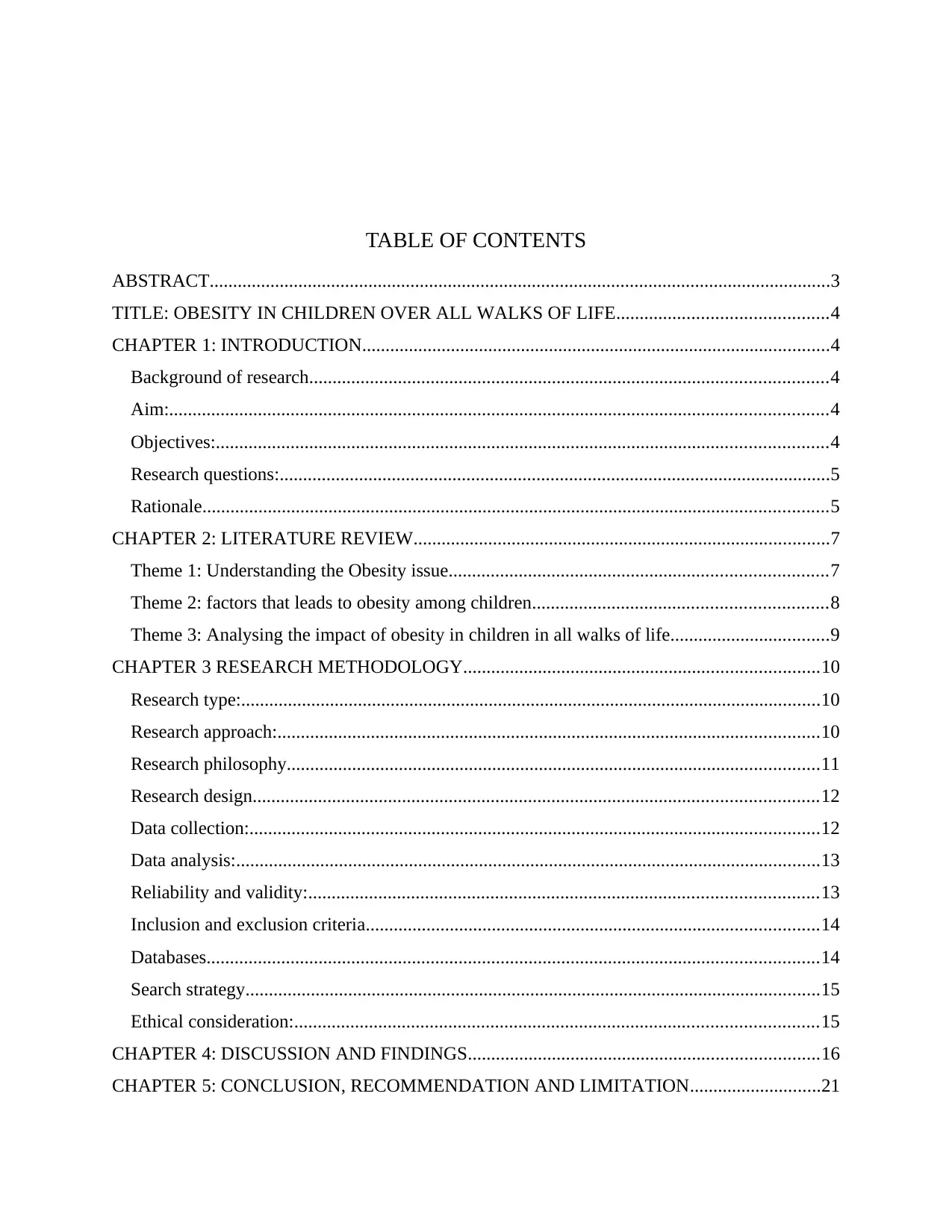
TABLE OF CONTENTS
ABSTRACT.....................................................................................................................................3
TITLE: OBESITY IN CHILDREN OVER ALL WALKS OF LIFE.............................................4
CHAPTER 1: INTRODUCTION....................................................................................................4
Background of research...............................................................................................................4
Aim:.............................................................................................................................................4
Objectives:...................................................................................................................................4
Research questions:......................................................................................................................5
Rationale......................................................................................................................................5
CHAPTER 2: LITERATURE REVIEW.........................................................................................7
Theme 1: Understanding the Obesity issue.................................................................................7
Theme 2: factors that leads to obesity among children...............................................................8
Theme 3: Analysing the impact of obesity in children in all walks of life..................................9
CHAPTER 3 RESEARCH METHODOLOGY............................................................................10
Research type:............................................................................................................................10
Research approach:....................................................................................................................10
Research philosophy..................................................................................................................11
Research design.........................................................................................................................12
Data collection:..........................................................................................................................12
Data analysis:.............................................................................................................................13
Reliability and validity:.............................................................................................................13
Inclusion and exclusion criteria.................................................................................................14
Databases...................................................................................................................................14
Search strategy...........................................................................................................................15
Ethical consideration:................................................................................................................15
CHAPTER 4: DISCUSSION AND FINDINGS...........................................................................16
CHAPTER 5: CONCLUSION, RECOMMENDATION AND LIMITATION............................21
ABSTRACT.....................................................................................................................................3
TITLE: OBESITY IN CHILDREN OVER ALL WALKS OF LIFE.............................................4
CHAPTER 1: INTRODUCTION....................................................................................................4
Background of research...............................................................................................................4
Aim:.............................................................................................................................................4
Objectives:...................................................................................................................................4
Research questions:......................................................................................................................5
Rationale......................................................................................................................................5
CHAPTER 2: LITERATURE REVIEW.........................................................................................7
Theme 1: Understanding the Obesity issue.................................................................................7
Theme 2: factors that leads to obesity among children...............................................................8
Theme 3: Analysing the impact of obesity in children in all walks of life..................................9
CHAPTER 3 RESEARCH METHODOLOGY............................................................................10
Research type:............................................................................................................................10
Research approach:....................................................................................................................10
Research philosophy..................................................................................................................11
Research design.........................................................................................................................12
Data collection:..........................................................................................................................12
Data analysis:.............................................................................................................................13
Reliability and validity:.............................................................................................................13
Inclusion and exclusion criteria.................................................................................................14
Databases...................................................................................................................................14
Search strategy...........................................................................................................................15
Ethical consideration:................................................................................................................15
CHAPTER 4: DISCUSSION AND FINDINGS...........................................................................16
CHAPTER 5: CONCLUSION, RECOMMENDATION AND LIMITATION............................21
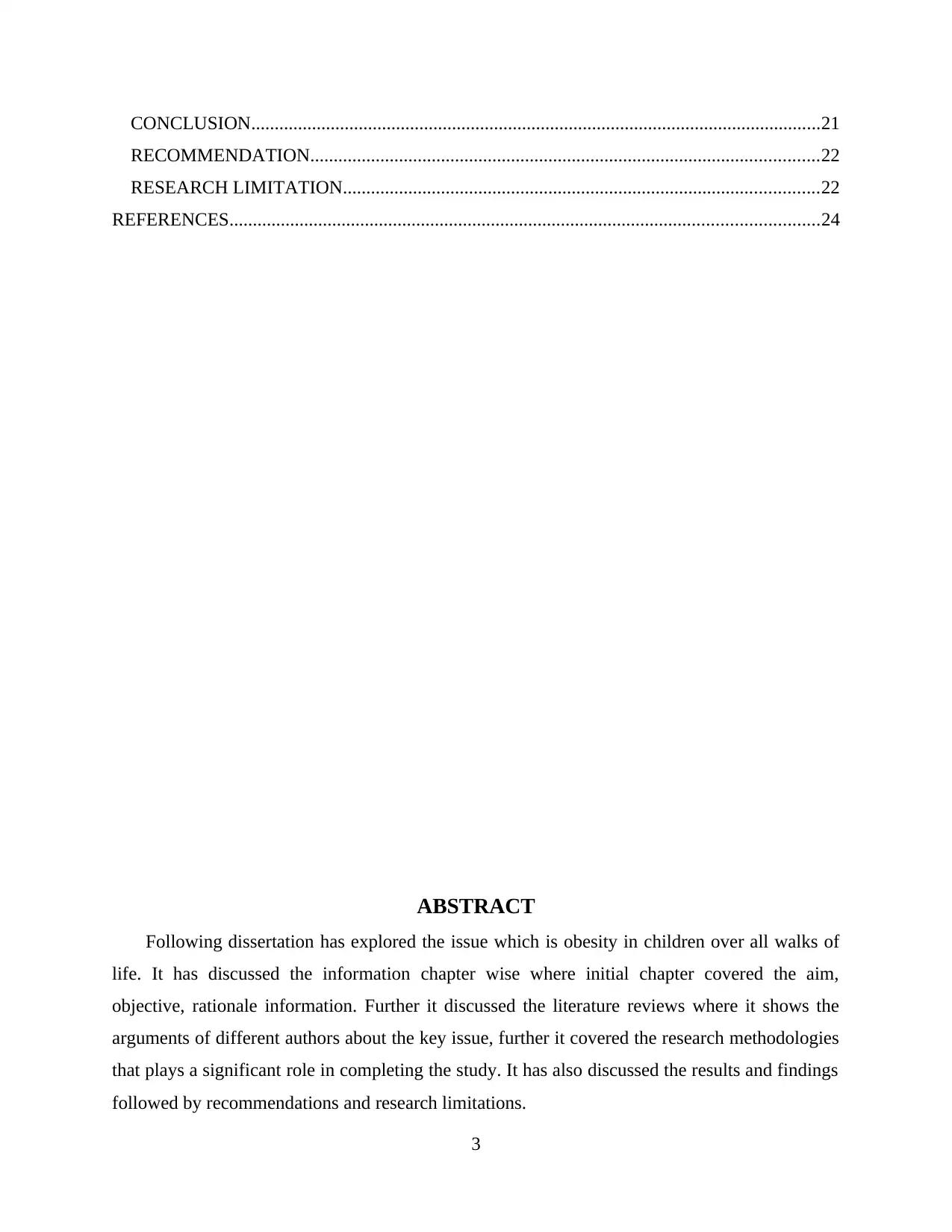
CONCLUSION..........................................................................................................................21
RECOMMENDATION.............................................................................................................22
RESEARCH LIMITATION......................................................................................................22
REFERENCES..............................................................................................................................24
ABSTRACT
Following dissertation has explored the issue which is obesity in children over all walks of
life. It has discussed the information chapter wise where initial chapter covered the aim,
objective, rationale information. Further it discussed the literature reviews where it shows the
arguments of different authors about the key issue, further it covered the research methodologies
that plays a significant role in completing the study. It has also discussed the results and findings
followed by recommendations and research limitations.
3
RECOMMENDATION.............................................................................................................22
RESEARCH LIMITATION......................................................................................................22
REFERENCES..............................................................................................................................24
ABSTRACT
Following dissertation has explored the issue which is obesity in children over all walks of
life. It has discussed the information chapter wise where initial chapter covered the aim,
objective, rationale information. Further it discussed the literature reviews where it shows the
arguments of different authors about the key issue, further it covered the research methodologies
that plays a significant role in completing the study. It has also discussed the results and findings
followed by recommendations and research limitations.
3
⊘ This is a preview!⊘
Do you want full access?
Subscribe today to unlock all pages.

Trusted by 1+ million students worldwide
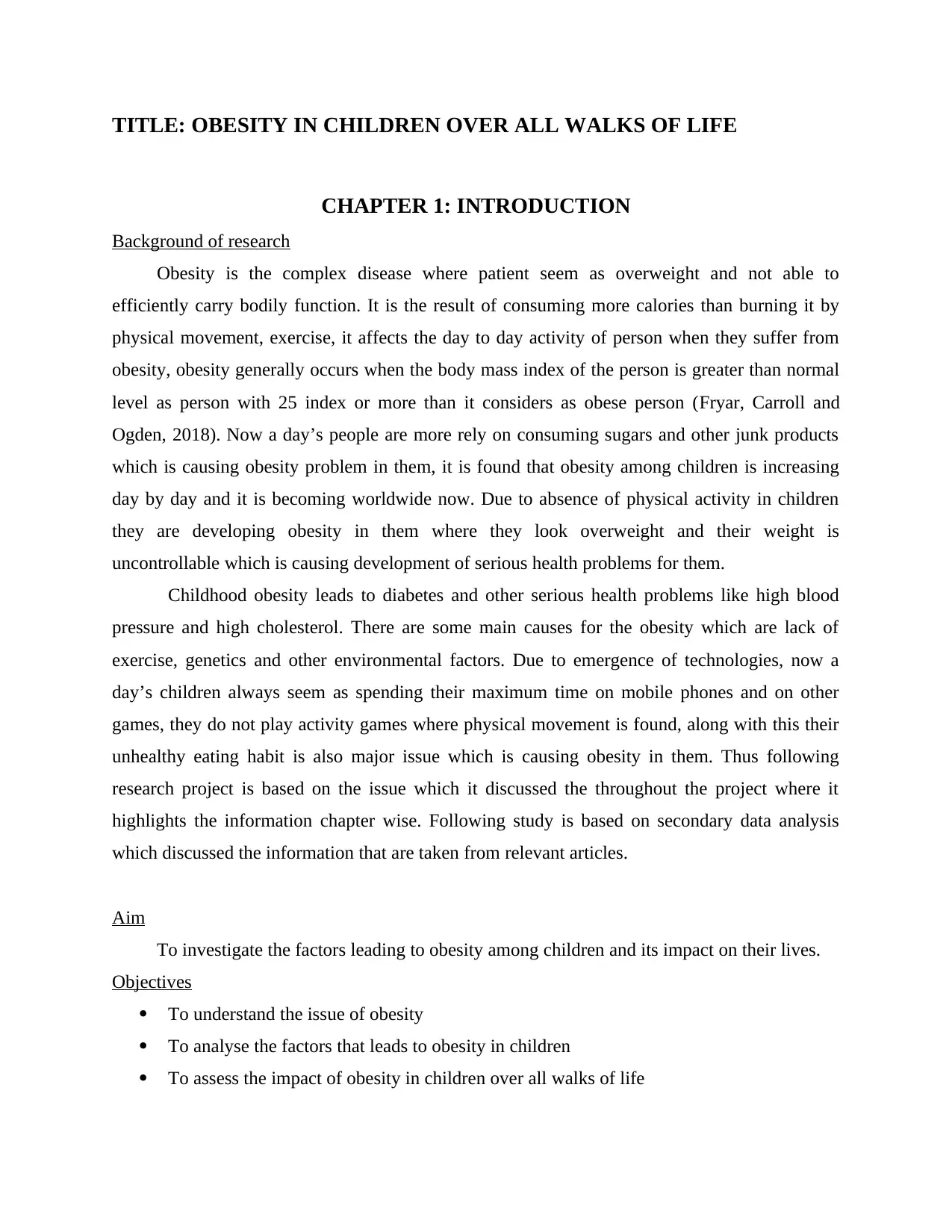
TITLE: OBESITY IN CHILDREN OVER ALL WALKS OF LIFE
CHAPTER 1: INTRODUCTION
Background of research
Obesity is the complex disease where patient seem as overweight and not able to
efficiently carry bodily function. It is the result of consuming more calories than burning it by
physical movement, exercise, it affects the day to day activity of person when they suffer from
obesity, obesity generally occurs when the body mass index of the person is greater than normal
level as person with 25 index or more than it considers as obese person (Fryar, Carroll and
Ogden, 2018). Now a day’s people are more rely on consuming sugars and other junk products
which is causing obesity problem in them, it is found that obesity among children is increasing
day by day and it is becoming worldwide now. Due to absence of physical activity in children
they are developing obesity in them where they look overweight and their weight is
uncontrollable which is causing development of serious health problems for them.
Childhood obesity leads to diabetes and other serious health problems like high blood
pressure and high cholesterol. There are some main causes for the obesity which are lack of
exercise, genetics and other environmental factors. Due to emergence of technologies, now a
day’s children always seem as spending their maximum time on mobile phones and on other
games, they do not play activity games where physical movement is found, along with this their
unhealthy eating habit is also major issue which is causing obesity in them. Thus following
research project is based on the issue which it discussed the throughout the project where it
highlights the information chapter wise. Following study is based on secondary data analysis
which discussed the information that are taken from relevant articles.
Aim
To investigate the factors leading to obesity among children and its impact on their lives.
Objectives
To understand the issue of obesity
To analyse the factors that leads to obesity in children
To assess the impact of obesity in children over all walks of life
CHAPTER 1: INTRODUCTION
Background of research
Obesity is the complex disease where patient seem as overweight and not able to
efficiently carry bodily function. It is the result of consuming more calories than burning it by
physical movement, exercise, it affects the day to day activity of person when they suffer from
obesity, obesity generally occurs when the body mass index of the person is greater than normal
level as person with 25 index or more than it considers as obese person (Fryar, Carroll and
Ogden, 2018). Now a day’s people are more rely on consuming sugars and other junk products
which is causing obesity problem in them, it is found that obesity among children is increasing
day by day and it is becoming worldwide now. Due to absence of physical activity in children
they are developing obesity in them where they look overweight and their weight is
uncontrollable which is causing development of serious health problems for them.
Childhood obesity leads to diabetes and other serious health problems like high blood
pressure and high cholesterol. There are some main causes for the obesity which are lack of
exercise, genetics and other environmental factors. Due to emergence of technologies, now a
day’s children always seem as spending their maximum time on mobile phones and on other
games, they do not play activity games where physical movement is found, along with this their
unhealthy eating habit is also major issue which is causing obesity in them. Thus following
research project is based on the issue which it discussed the throughout the project where it
highlights the information chapter wise. Following study is based on secondary data analysis
which discussed the information that are taken from relevant articles.
Aim
To investigate the factors leading to obesity among children and its impact on their lives.
Objectives
To understand the issue of obesity
To analyse the factors that leads to obesity in children
To assess the impact of obesity in children over all walks of life
Paraphrase This Document
Need a fresh take? Get an instant paraphrase of this document with our AI Paraphraser
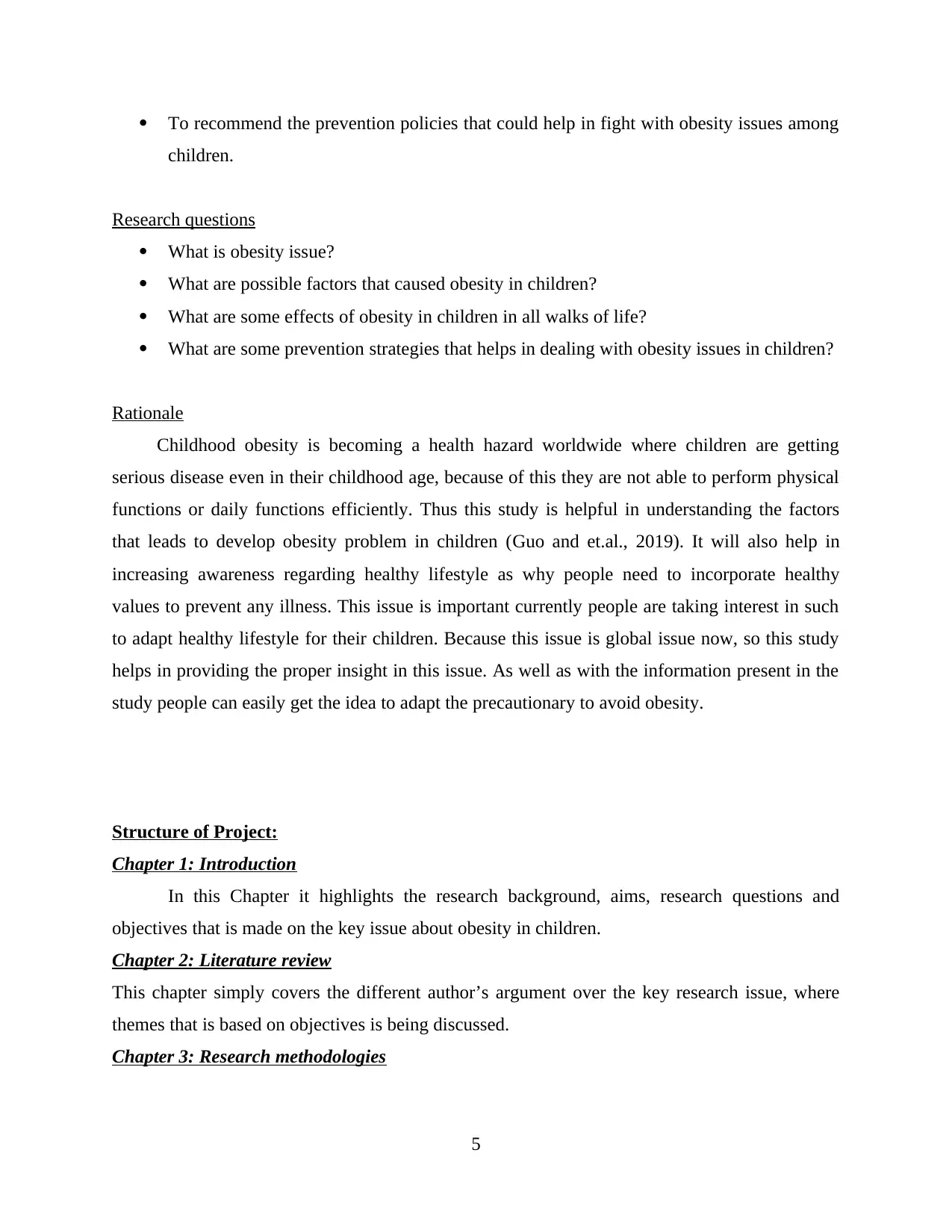
To recommend the prevention policies that could help in fight with obesity issues among
children.
Research questions
What is obesity issue?
What are possible factors that caused obesity in children?
What are some effects of obesity in children in all walks of life?
What are some prevention strategies that helps in dealing with obesity issues in children?
Rationale
Childhood obesity is becoming a health hazard worldwide where children are getting
serious disease even in their childhood age, because of this they are not able to perform physical
functions or daily functions efficiently. Thus this study is helpful in understanding the factors
that leads to develop obesity problem in children (Guo and et.al., 2019). It will also help in
increasing awareness regarding healthy lifestyle as why people need to incorporate healthy
values to prevent any illness. This issue is important currently people are taking interest in such
to adapt healthy lifestyle for their children. Because this issue is global issue now, so this study
helps in providing the proper insight in this issue. As well as with the information present in the
study people can easily get the idea to adapt the precautionary to avoid obesity.
Structure of Project:
Chapter 1: Introduction
In this Chapter it highlights the research background, aims, research questions and
objectives that is made on the key issue about obesity in children.
Chapter 2: Literature review
This chapter simply covers the different author’s argument over the key research issue, where
themes that is based on objectives is being discussed.
Chapter 3: Research methodologies
5
children.
Research questions
What is obesity issue?
What are possible factors that caused obesity in children?
What are some effects of obesity in children in all walks of life?
What are some prevention strategies that helps in dealing with obesity issues in children?
Rationale
Childhood obesity is becoming a health hazard worldwide where children are getting
serious disease even in their childhood age, because of this they are not able to perform physical
functions or daily functions efficiently. Thus this study is helpful in understanding the factors
that leads to develop obesity problem in children (Guo and et.al., 2019). It will also help in
increasing awareness regarding healthy lifestyle as why people need to incorporate healthy
values to prevent any illness. This issue is important currently people are taking interest in such
to adapt healthy lifestyle for their children. Because this issue is global issue now, so this study
helps in providing the proper insight in this issue. As well as with the information present in the
study people can easily get the idea to adapt the precautionary to avoid obesity.
Structure of Project:
Chapter 1: Introduction
In this Chapter it highlights the research background, aims, research questions and
objectives that is made on the key issue about obesity in children.
Chapter 2: Literature review
This chapter simply covers the different author’s argument over the key research issue, where
themes that is based on objectives is being discussed.
Chapter 3: Research methodologies
5
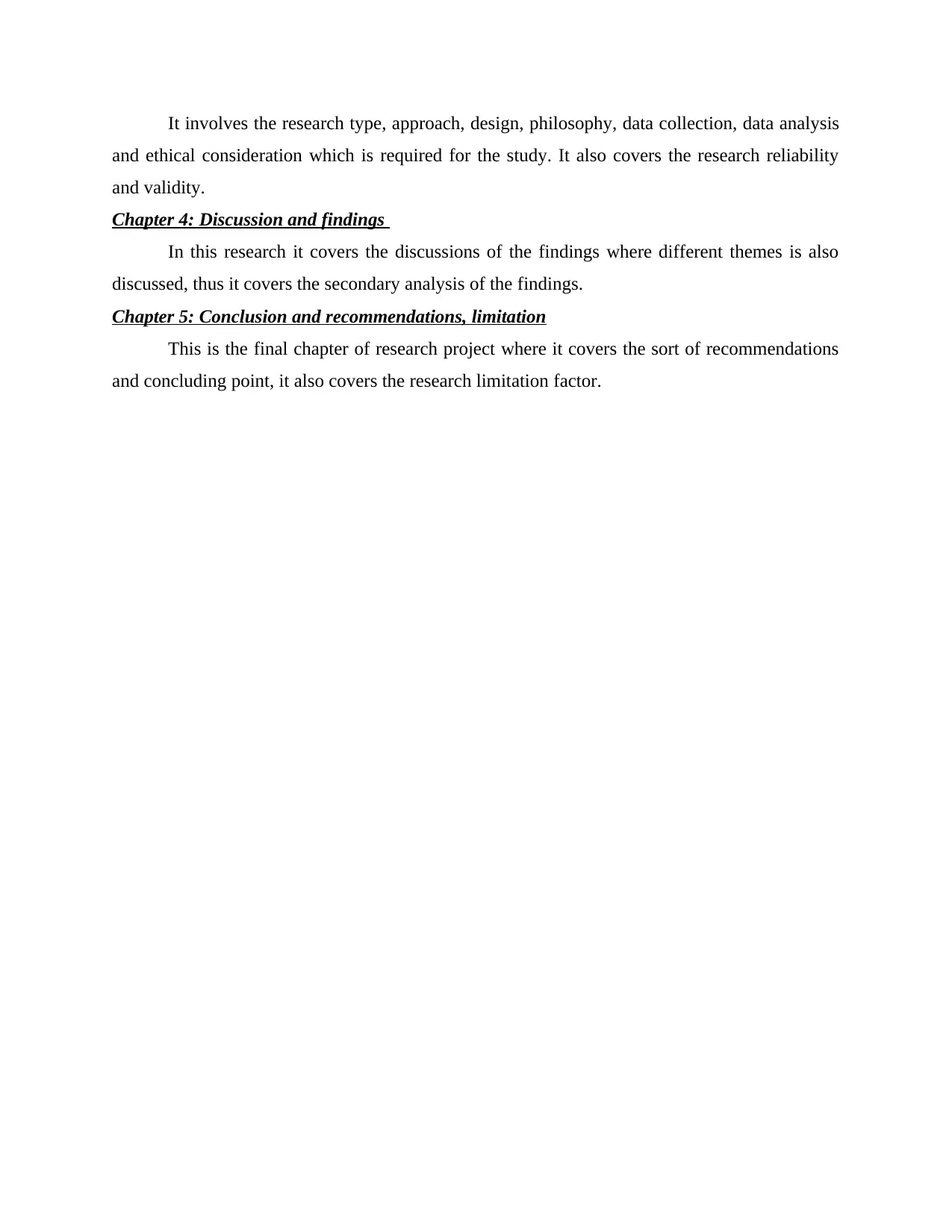
It involves the research type, approach, design, philosophy, data collection, data analysis
and ethical consideration which is required for the study. It also covers the research reliability
and validity.
Chapter 4: Discussion and findings
In this research it covers the discussions of the findings where different themes is also
discussed, thus it covers the secondary analysis of the findings.
Chapter 5: Conclusion and recommendations, limitation
This is the final chapter of research project where it covers the sort of recommendations
and concluding point, it also covers the research limitation factor.
and ethical consideration which is required for the study. It also covers the research reliability
and validity.
Chapter 4: Discussion and findings
In this research it covers the discussions of the findings where different themes is also
discussed, thus it covers the secondary analysis of the findings.
Chapter 5: Conclusion and recommendations, limitation
This is the final chapter of research project where it covers the sort of recommendations
and concluding point, it also covers the research limitation factor.
⊘ This is a preview!⊘
Do you want full access?
Subscribe today to unlock all pages.

Trusted by 1+ million students worldwide
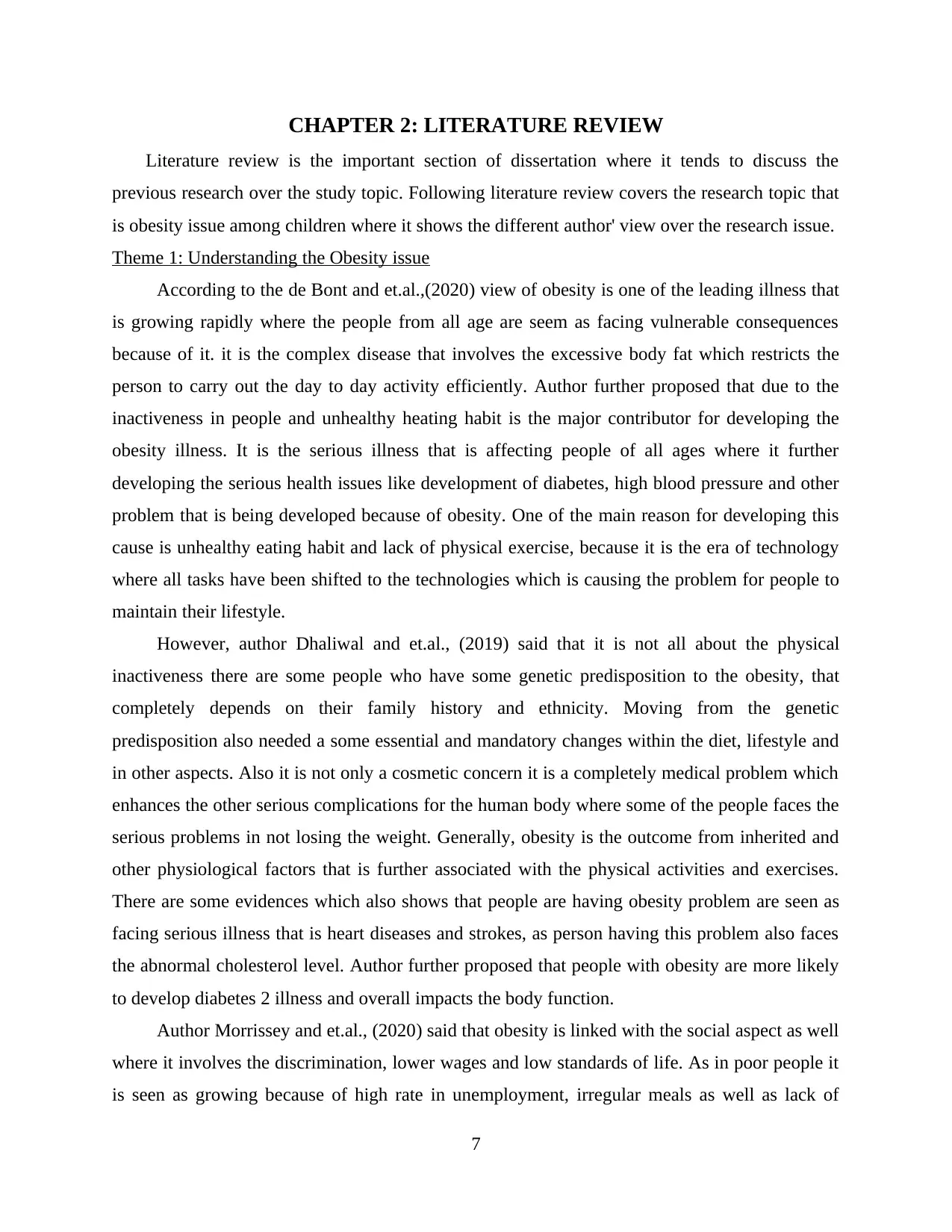
CHAPTER 2: LITERATURE REVIEW
Literature review is the important section of dissertation where it tends to discuss the
previous research over the study topic. Following literature review covers the research topic that
is obesity issue among children where it shows the different author' view over the research issue.
Theme 1: Understanding the Obesity issue
According to the de Bont and et.al.,(2020) view of obesity is one of the leading illness that
is growing rapidly where the people from all age are seem as facing vulnerable consequences
because of it. it is the complex disease that involves the excessive body fat which restricts the
person to carry out the day to day activity efficiently. Author further proposed that due to the
inactiveness in people and unhealthy heating habit is the major contributor for developing the
obesity illness. It is the serious illness that is affecting people of all ages where it further
developing the serious health issues like development of diabetes, high blood pressure and other
problem that is being developed because of obesity. One of the main reason for developing this
cause is unhealthy eating habit and lack of physical exercise, because it is the era of technology
where all tasks have been shifted to the technologies which is causing the problem for people to
maintain their lifestyle.
However, author Dhaliwal and et.al., (2019) said that it is not all about the physical
inactiveness there are some people who have some genetic predisposition to the obesity, that
completely depends on their family history and ethnicity. Moving from the genetic
predisposition also needed a some essential and mandatory changes within the diet, lifestyle and
in other aspects. Also it is not only a cosmetic concern it is a completely medical problem which
enhances the other serious complications for the human body where some of the people faces the
serious problems in not losing the weight. Generally, obesity is the outcome from inherited and
other physiological factors that is further associated with the physical activities and exercises.
There are some evidences which also shows that people are having obesity problem are seen as
facing serious illness that is heart diseases and strokes, as person having this problem also faces
the abnormal cholesterol level. Author further proposed that people with obesity are more likely
to develop diabetes 2 illness and overall impacts the body function.
Author Morrissey and et.al., (2020) said that obesity is linked with the social aspect as well
where it involves the discrimination, lower wages and low standards of life. As in poor people it
is seen as growing because of high rate in unemployment, irregular meals as well as lack of
7
Literature review is the important section of dissertation where it tends to discuss the
previous research over the study topic. Following literature review covers the research topic that
is obesity issue among children where it shows the different author' view over the research issue.
Theme 1: Understanding the Obesity issue
According to the de Bont and et.al.,(2020) view of obesity is one of the leading illness that
is growing rapidly where the people from all age are seem as facing vulnerable consequences
because of it. it is the complex disease that involves the excessive body fat which restricts the
person to carry out the day to day activity efficiently. Author further proposed that due to the
inactiveness in people and unhealthy heating habit is the major contributor for developing the
obesity illness. It is the serious illness that is affecting people of all ages where it further
developing the serious health issues like development of diabetes, high blood pressure and other
problem that is being developed because of obesity. One of the main reason for developing this
cause is unhealthy eating habit and lack of physical exercise, because it is the era of technology
where all tasks have been shifted to the technologies which is causing the problem for people to
maintain their lifestyle.
However, author Dhaliwal and et.al., (2019) said that it is not all about the physical
inactiveness there are some people who have some genetic predisposition to the obesity, that
completely depends on their family history and ethnicity. Moving from the genetic
predisposition also needed a some essential and mandatory changes within the diet, lifestyle and
in other aspects. Also it is not only a cosmetic concern it is a completely medical problem which
enhances the other serious complications for the human body where some of the people faces the
serious problems in not losing the weight. Generally, obesity is the outcome from inherited and
other physiological factors that is further associated with the physical activities and exercises.
There are some evidences which also shows that people are having obesity problem are seen as
facing serious illness that is heart diseases and strokes, as person having this problem also faces
the abnormal cholesterol level. Author further proposed that people with obesity are more likely
to develop diabetes 2 illness and overall impacts the body function.
Author Morrissey and et.al., (2020) said that obesity is linked with the social aspect as well
where it involves the discrimination, lower wages and low standards of life. As in poor people it
is seen as growing because of high rate in unemployment, irregular meals as well as lack of
7
Paraphrase This Document
Need a fresh take? Get an instant paraphrase of this document with our AI Paraphraser
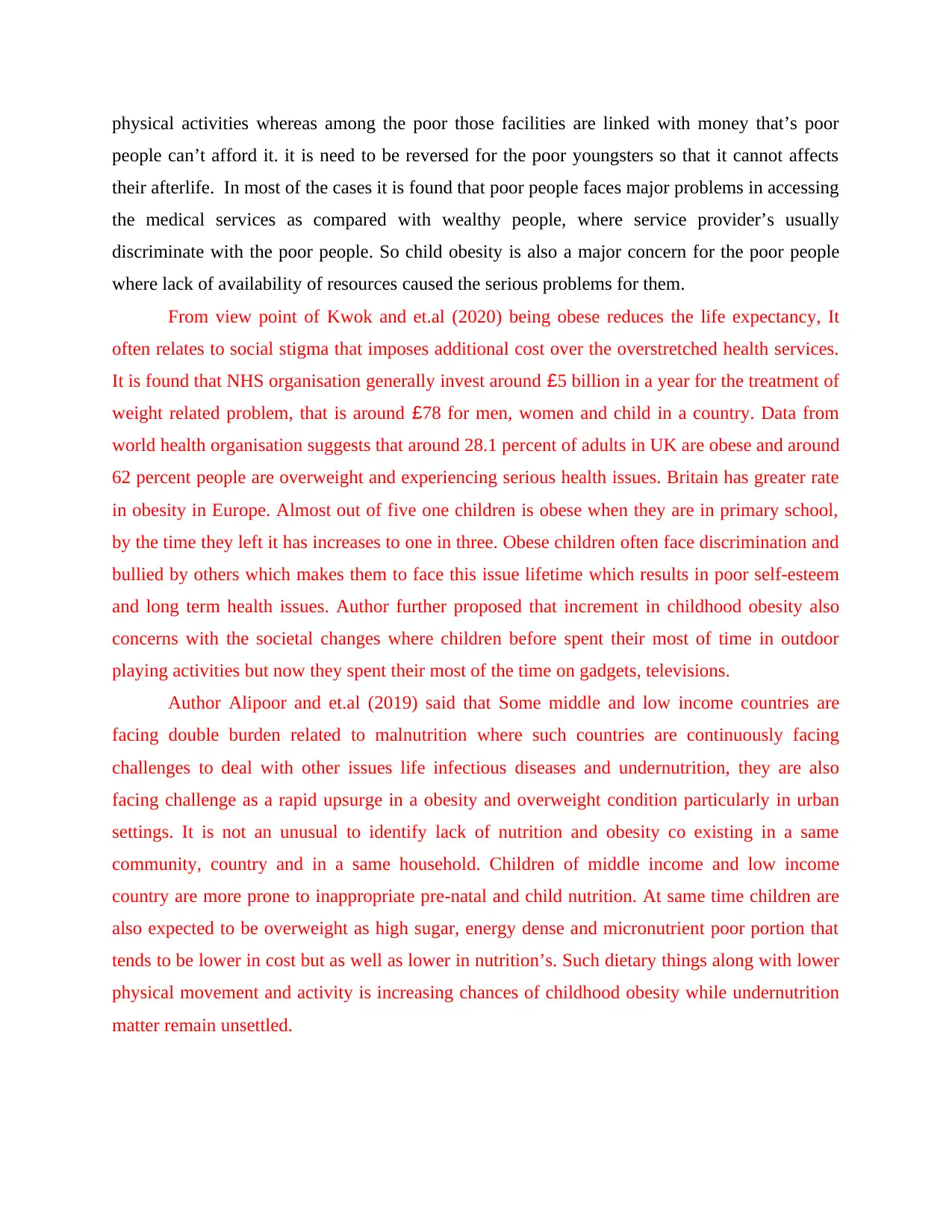
physical activities whereas among the poor those facilities are linked with money that’s poor
people can’t afford it. it is need to be reversed for the poor youngsters so that it cannot affects
their afterlife. In most of the cases it is found that poor people faces major problems in accessing
the medical services as compared with wealthy people, where service provider’s usually
discriminate with the poor people. So child obesity is also a major concern for the poor people
where lack of availability of resources caused the serious problems for them.
From view point of Kwok and et.al (2020) being obese reduces the life expectancy, It
often relates to social stigma that imposes additional cost over the overstretched health services.
It is found that NHS organisation generally invest around £5 billion in a year for the treatment of
weight related problem, that is around £78 for men, women and child in a country. Data from
world health organisation suggests that around 28.1 percent of adults in UK are obese and around
62 percent people are overweight and experiencing serious health issues. Britain has greater rate
in obesity in Europe. Almost out of five one children is obese when they are in primary school,
by the time they left it has increases to one in three. Obese children often face discrimination and
bullied by others which makes them to face this issue lifetime which results in poor self-esteem
and long term health issues. Author further proposed that increment in childhood obesity also
concerns with the societal changes where children before spent their most of time in outdoor
playing activities but now they spent their most of the time on gadgets, televisions.
Author Alipoor and et.al (2019) said that Some middle and low income countries are
facing double burden related to malnutrition where such countries are continuously facing
challenges to deal with other issues life infectious diseases and undernutrition, they are also
facing challenge as a rapid upsurge in a obesity and overweight condition particularly in urban
settings. It is not an unusual to identify lack of nutrition and obesity co existing in a same
community, country and in a same household. Children of middle income and low income
country are more prone to inappropriate pre-natal and child nutrition. At same time children are
also expected to be overweight as high sugar, energy dense and micronutrient poor portion that
tends to be lower in cost but as well as lower in nutrition’s. Such dietary things along with lower
physical movement and activity is increasing chances of childhood obesity while undernutrition
matter remain unsettled.
people can’t afford it. it is need to be reversed for the poor youngsters so that it cannot affects
their afterlife. In most of the cases it is found that poor people faces major problems in accessing
the medical services as compared with wealthy people, where service provider’s usually
discriminate with the poor people. So child obesity is also a major concern for the poor people
where lack of availability of resources caused the serious problems for them.
From view point of Kwok and et.al (2020) being obese reduces the life expectancy, It
often relates to social stigma that imposes additional cost over the overstretched health services.
It is found that NHS organisation generally invest around £5 billion in a year for the treatment of
weight related problem, that is around £78 for men, women and child in a country. Data from
world health organisation suggests that around 28.1 percent of adults in UK are obese and around
62 percent people are overweight and experiencing serious health issues. Britain has greater rate
in obesity in Europe. Almost out of five one children is obese when they are in primary school,
by the time they left it has increases to one in three. Obese children often face discrimination and
bullied by others which makes them to face this issue lifetime which results in poor self-esteem
and long term health issues. Author further proposed that increment in childhood obesity also
concerns with the societal changes where children before spent their most of time in outdoor
playing activities but now they spent their most of the time on gadgets, televisions.
Author Alipoor and et.al (2019) said that Some middle and low income countries are
facing double burden related to malnutrition where such countries are continuously facing
challenges to deal with other issues life infectious diseases and undernutrition, they are also
facing challenge as a rapid upsurge in a obesity and overweight condition particularly in urban
settings. It is not an unusual to identify lack of nutrition and obesity co existing in a same
community, country and in a same household. Children of middle income and low income
country are more prone to inappropriate pre-natal and child nutrition. At same time children are
also expected to be overweight as high sugar, energy dense and micronutrient poor portion that
tends to be lower in cost but as well as lower in nutrition’s. Such dietary things along with lower
physical movement and activity is increasing chances of childhood obesity while undernutrition
matter remain unsettled.
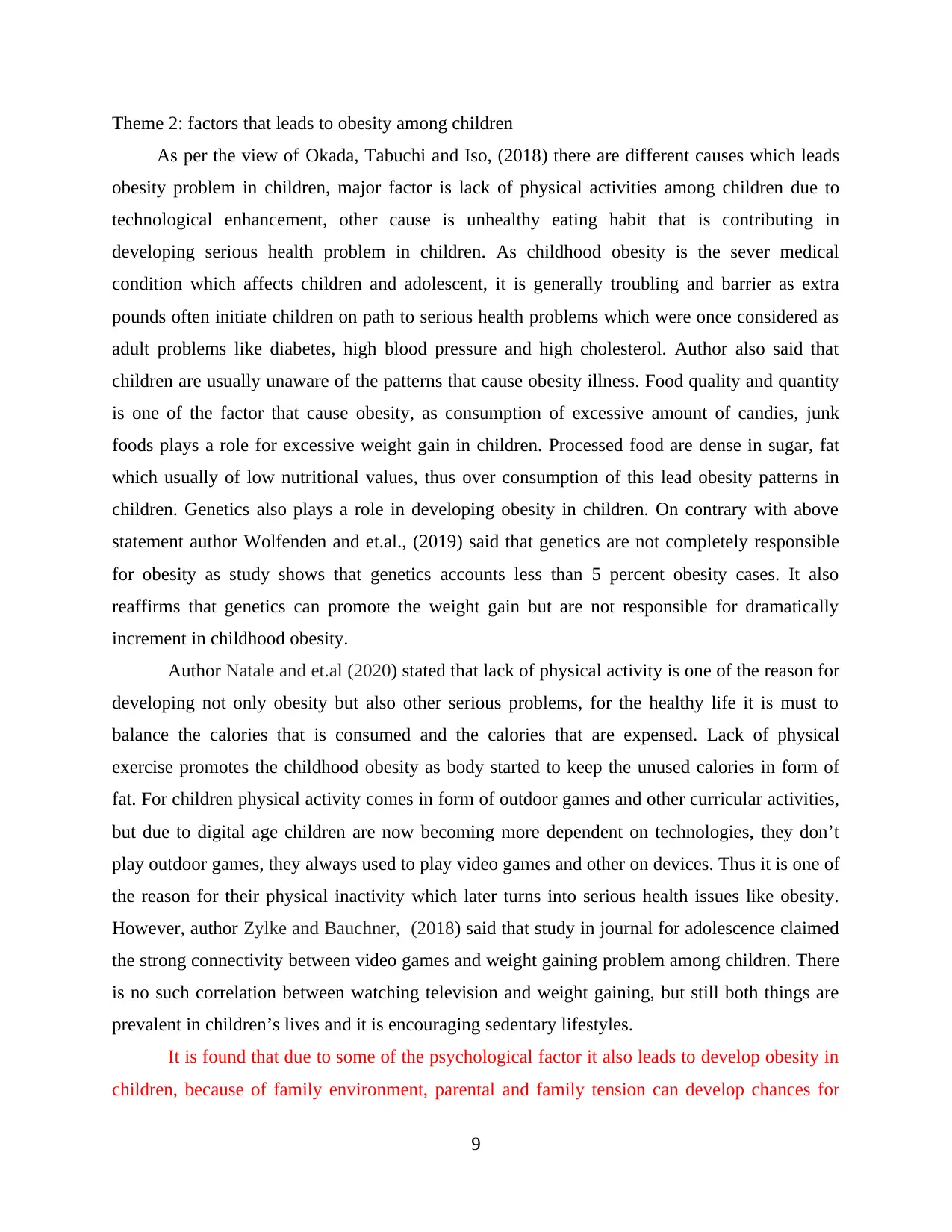
Theme 2: factors that leads to obesity among children
As per the view of Okada, Tabuchi and Iso, (2018) there are different causes which leads
obesity problem in children, major factor is lack of physical activities among children due to
technological enhancement, other cause is unhealthy eating habit that is contributing in
developing serious health problem in children. As childhood obesity is the sever medical
condition which affects children and adolescent, it is generally troubling and barrier as extra
pounds often initiate children on path to serious health problems which were once considered as
adult problems like diabetes, high blood pressure and high cholesterol. Author also said that
children are usually unaware of the patterns that cause obesity illness. Food quality and quantity
is one of the factor that cause obesity, as consumption of excessive amount of candies, junk
foods plays a role for excessive weight gain in children. Processed food are dense in sugar, fat
which usually of low nutritional values, thus over consumption of this lead obesity patterns in
children. Genetics also plays a role in developing obesity in children. On contrary with above
statement author Wolfenden and et.al., (2019) said that genetics are not completely responsible
for obesity as study shows that genetics accounts less than 5 percent obesity cases. It also
reaffirms that genetics can promote the weight gain but are not responsible for dramatically
increment in childhood obesity.
Author Natale and et.al (2020) stated that lack of physical activity is one of the reason for
developing not only obesity but also other serious problems, for the healthy life it is must to
balance the calories that is consumed and the calories that are expensed. Lack of physical
exercise promotes the childhood obesity as body started to keep the unused calories in form of
fat. For children physical activity comes in form of outdoor games and other curricular activities,
but due to digital age children are now becoming more dependent on technologies, they don’t
play outdoor games, they always used to play video games and other on devices. Thus it is one of
the reason for their physical inactivity which later turns into serious health issues like obesity.
However, author Zylke and Bauchner, (2018) said that study in journal for adolescence claimed
the strong connectivity between video games and weight gaining problem among children. There
is no such correlation between watching television and weight gaining, but still both things are
prevalent in children’s lives and it is encouraging sedentary lifestyles.
It is found that due to some of the psychological factor it also leads to develop obesity in
children, because of family environment, parental and family tension can develop chances for
9
As per the view of Okada, Tabuchi and Iso, (2018) there are different causes which leads
obesity problem in children, major factor is lack of physical activities among children due to
technological enhancement, other cause is unhealthy eating habit that is contributing in
developing serious health problem in children. As childhood obesity is the sever medical
condition which affects children and adolescent, it is generally troubling and barrier as extra
pounds often initiate children on path to serious health problems which were once considered as
adult problems like diabetes, high blood pressure and high cholesterol. Author also said that
children are usually unaware of the patterns that cause obesity illness. Food quality and quantity
is one of the factor that cause obesity, as consumption of excessive amount of candies, junk
foods plays a role for excessive weight gain in children. Processed food are dense in sugar, fat
which usually of low nutritional values, thus over consumption of this lead obesity patterns in
children. Genetics also plays a role in developing obesity in children. On contrary with above
statement author Wolfenden and et.al., (2019) said that genetics are not completely responsible
for obesity as study shows that genetics accounts less than 5 percent obesity cases. It also
reaffirms that genetics can promote the weight gain but are not responsible for dramatically
increment in childhood obesity.
Author Natale and et.al (2020) stated that lack of physical activity is one of the reason for
developing not only obesity but also other serious problems, for the healthy life it is must to
balance the calories that is consumed and the calories that are expensed. Lack of physical
exercise promotes the childhood obesity as body started to keep the unused calories in form of
fat. For children physical activity comes in form of outdoor games and other curricular activities,
but due to digital age children are now becoming more dependent on technologies, they don’t
play outdoor games, they always used to play video games and other on devices. Thus it is one of
the reason for their physical inactivity which later turns into serious health issues like obesity.
However, author Zylke and Bauchner, (2018) said that study in journal for adolescence claimed
the strong connectivity between video games and weight gaining problem among children. There
is no such correlation between watching television and weight gaining, but still both things are
prevalent in children’s lives and it is encouraging sedentary lifestyles.
It is found that due to some of the psychological factor it also leads to develop obesity in
children, because of family environment, parental and family tension can develop chances for
9
⊘ This is a preview!⊘
Do you want full access?
Subscribe today to unlock all pages.

Trusted by 1+ million students worldwide
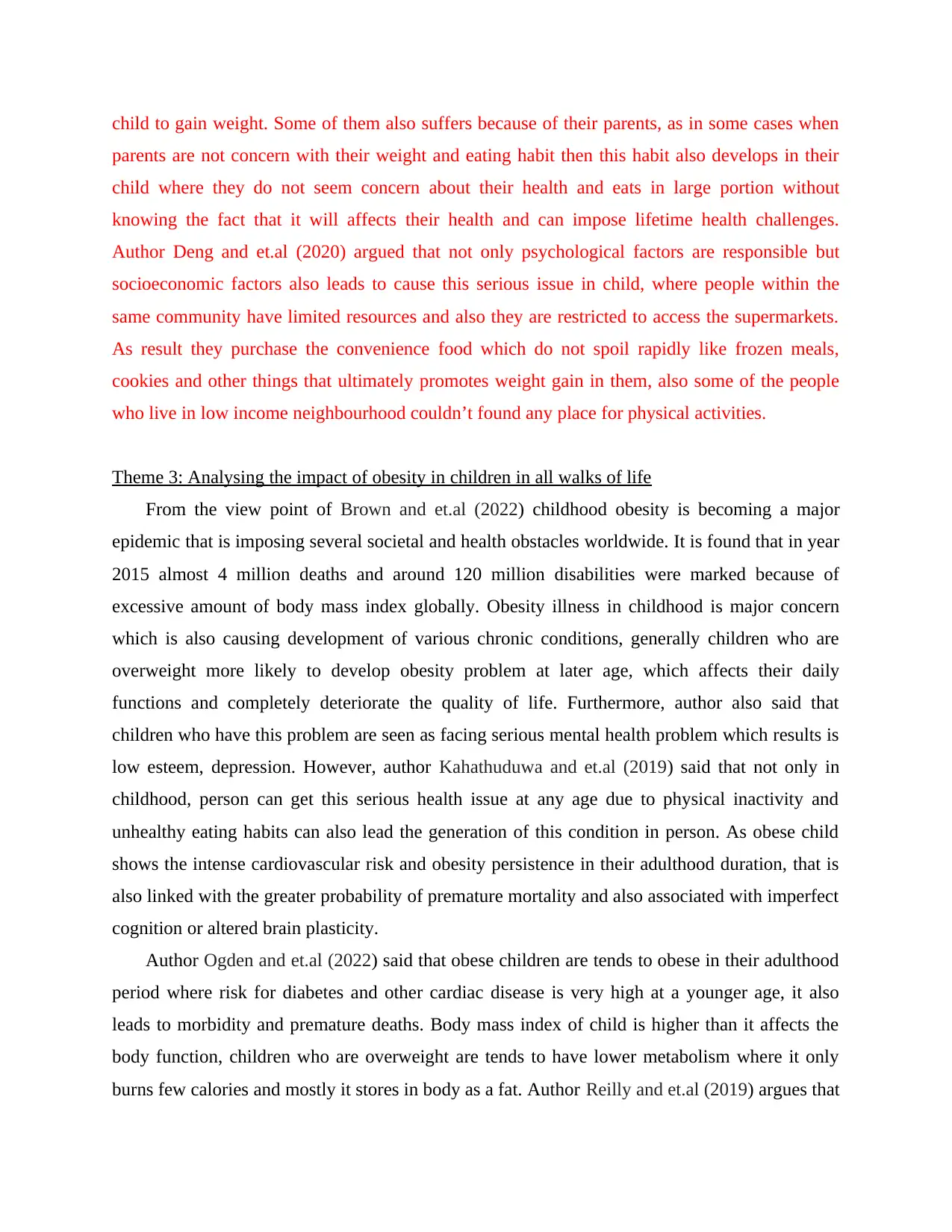
child to gain weight. Some of them also suffers because of their parents, as in some cases when
parents are not concern with their weight and eating habit then this habit also develops in their
child where they do not seem concern about their health and eats in large portion without
knowing the fact that it will affects their health and can impose lifetime health challenges.
Author Deng and et.al (2020) argued that not only psychological factors are responsible but
socioeconomic factors also leads to cause this serious issue in child, where people within the
same community have limited resources and also they are restricted to access the supermarkets.
As result they purchase the convenience food which do not spoil rapidly like frozen meals,
cookies and other things that ultimately promotes weight gain in them, also some of the people
who live in low income neighbourhood couldn’t found any place for physical activities.
Theme 3: Analysing the impact of obesity in children in all walks of life
From the view point of Brown and et.al (2022) childhood obesity is becoming a major
epidemic that is imposing several societal and health obstacles worldwide. It is found that in year
2015 almost 4 million deaths and around 120 million disabilities were marked because of
excessive amount of body mass index globally. Obesity illness in childhood is major concern
which is also causing development of various chronic conditions, generally children who are
overweight more likely to develop obesity problem at later age, which affects their daily
functions and completely deteriorate the quality of life. Furthermore, author also said that
children who have this problem are seen as facing serious mental health problem which results is
low esteem, depression. However, author Kahathuduwa and et.al (2019) said that not only in
childhood, person can get this serious health issue at any age due to physical inactivity and
unhealthy eating habits can also lead the generation of this condition in person. As obese child
shows the intense cardiovascular risk and obesity persistence in their adulthood duration, that is
also linked with the greater probability of premature mortality and also associated with imperfect
cognition or altered brain plasticity.
Author Ogden and et.al (2022) said that obese children are tends to obese in their adulthood
period where risk for diabetes and other cardiac disease is very high at a younger age, it also
leads to morbidity and premature deaths. Body mass index of child is higher than it affects the
body function, children who are overweight are tends to have lower metabolism where it only
burns few calories and mostly it stores in body as a fat. Author Reilly and et.al (2019) argues that
parents are not concern with their weight and eating habit then this habit also develops in their
child where they do not seem concern about their health and eats in large portion without
knowing the fact that it will affects their health and can impose lifetime health challenges.
Author Deng and et.al (2020) argued that not only psychological factors are responsible but
socioeconomic factors also leads to cause this serious issue in child, where people within the
same community have limited resources and also they are restricted to access the supermarkets.
As result they purchase the convenience food which do not spoil rapidly like frozen meals,
cookies and other things that ultimately promotes weight gain in them, also some of the people
who live in low income neighbourhood couldn’t found any place for physical activities.
Theme 3: Analysing the impact of obesity in children in all walks of life
From the view point of Brown and et.al (2022) childhood obesity is becoming a major
epidemic that is imposing several societal and health obstacles worldwide. It is found that in year
2015 almost 4 million deaths and around 120 million disabilities were marked because of
excessive amount of body mass index globally. Obesity illness in childhood is major concern
which is also causing development of various chronic conditions, generally children who are
overweight more likely to develop obesity problem at later age, which affects their daily
functions and completely deteriorate the quality of life. Furthermore, author also said that
children who have this problem are seen as facing serious mental health problem which results is
low esteem, depression. However, author Kahathuduwa and et.al (2019) said that not only in
childhood, person can get this serious health issue at any age due to physical inactivity and
unhealthy eating habits can also lead the generation of this condition in person. As obese child
shows the intense cardiovascular risk and obesity persistence in their adulthood duration, that is
also linked with the greater probability of premature mortality and also associated with imperfect
cognition or altered brain plasticity.
Author Ogden and et.al (2022) said that obese children are tends to obese in their adulthood
period where risk for diabetes and other cardiac disease is very high at a younger age, it also
leads to morbidity and premature deaths. Body mass index of child is higher than it affects the
body function, children who are overweight are tends to have lower metabolism where it only
burns few calories and mostly it stores in body as a fat. Author Reilly and et.al (2019) argues that
Paraphrase This Document
Need a fresh take? Get an instant paraphrase of this document with our AI Paraphraser

indeed metabolism is linked with the weight but it completely contradicts with the common
belief that is steady metabolism hardly cause of major weight gain.
11
belief that is steady metabolism hardly cause of major weight gain.
11
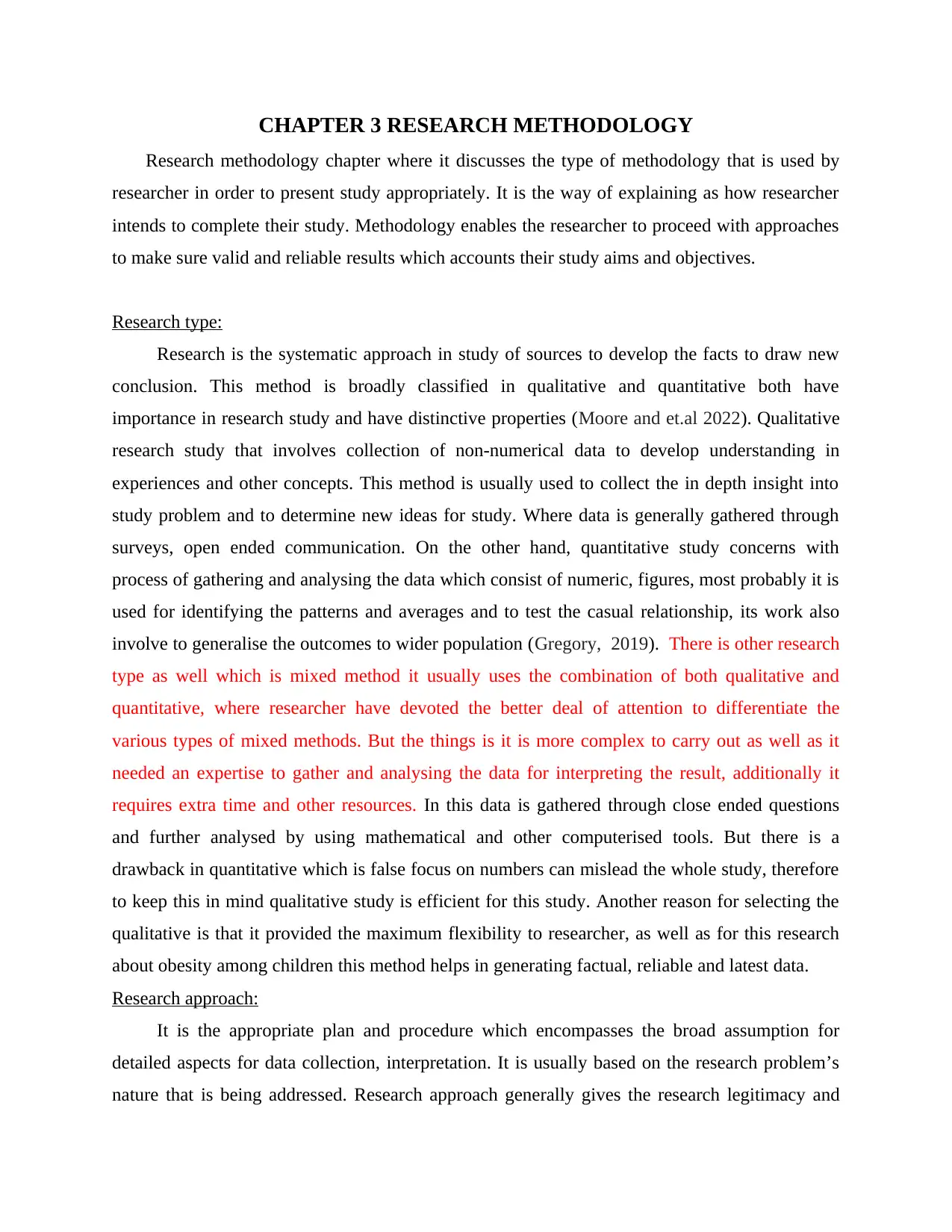
CHAPTER 3 RESEARCH METHODOLOGY
Research methodology chapter where it discusses the type of methodology that is used by
researcher in order to present study appropriately. It is the way of explaining as how researcher
intends to complete their study. Methodology enables the researcher to proceed with approaches
to make sure valid and reliable results which accounts their study aims and objectives.
Research type:
Research is the systematic approach in study of sources to develop the facts to draw new
conclusion. This method is broadly classified in qualitative and quantitative both have
importance in research study and have distinctive properties (Moore and et.al 2022). Qualitative
research study that involves collection of non-numerical data to develop understanding in
experiences and other concepts. This method is usually used to collect the in depth insight into
study problem and to determine new ideas for study. Where data is generally gathered through
surveys, open ended communication. On the other hand, quantitative study concerns with
process of gathering and analysing the data which consist of numeric, figures, most probably it is
used for identifying the patterns and averages and to test the casual relationship, its work also
involve to generalise the outcomes to wider population (Gregory, 2019). There is other research
type as well which is mixed method it usually uses the combination of both qualitative and
quantitative, where researcher have devoted the better deal of attention to differentiate the
various types of mixed methods. But the things is it is more complex to carry out as well as it
needed an expertise to gather and analysing the data for interpreting the result, additionally it
requires extra time and other resources. In this data is gathered through close ended questions
and further analysed by using mathematical and other computerised tools. But there is a
drawback in quantitative which is false focus on numbers can mislead the whole study, therefore
to keep this in mind qualitative study is efficient for this study. Another reason for selecting the
qualitative is that it provided the maximum flexibility to researcher, as well as for this research
about obesity among children this method helps in generating factual, reliable and latest data.
Research approach:
It is the appropriate plan and procedure which encompasses the broad assumption for
detailed aspects for data collection, interpretation. It is usually based on the research problem’s
nature that is being addressed. Research approach generally gives the research legitimacy and
Research methodology chapter where it discusses the type of methodology that is used by
researcher in order to present study appropriately. It is the way of explaining as how researcher
intends to complete their study. Methodology enables the researcher to proceed with approaches
to make sure valid and reliable results which accounts their study aims and objectives.
Research type:
Research is the systematic approach in study of sources to develop the facts to draw new
conclusion. This method is broadly classified in qualitative and quantitative both have
importance in research study and have distinctive properties (Moore and et.al 2022). Qualitative
research study that involves collection of non-numerical data to develop understanding in
experiences and other concepts. This method is usually used to collect the in depth insight into
study problem and to determine new ideas for study. Where data is generally gathered through
surveys, open ended communication. On the other hand, quantitative study concerns with
process of gathering and analysing the data which consist of numeric, figures, most probably it is
used for identifying the patterns and averages and to test the casual relationship, its work also
involve to generalise the outcomes to wider population (Gregory, 2019). There is other research
type as well which is mixed method it usually uses the combination of both qualitative and
quantitative, where researcher have devoted the better deal of attention to differentiate the
various types of mixed methods. But the things is it is more complex to carry out as well as it
needed an expertise to gather and analysing the data for interpreting the result, additionally it
requires extra time and other resources. In this data is gathered through close ended questions
and further analysed by using mathematical and other computerised tools. But there is a
drawback in quantitative which is false focus on numbers can mislead the whole study, therefore
to keep this in mind qualitative study is efficient for this study. Another reason for selecting the
qualitative is that it provided the maximum flexibility to researcher, as well as for this research
about obesity among children this method helps in generating factual, reliable and latest data.
Research approach:
It is the appropriate plan and procedure which encompasses the broad assumption for
detailed aspects for data collection, interpretation. It is usually based on the research problem’s
nature that is being addressed. Research approach generally gives the research legitimacy and
⊘ This is a preview!⊘
Do you want full access?
Subscribe today to unlock all pages.

Trusted by 1+ million students worldwide
1 out of 28
Related Documents
Your All-in-One AI-Powered Toolkit for Academic Success.
+13062052269
info@desklib.com
Available 24*7 on WhatsApp / Email
![[object Object]](/_next/static/media/star-bottom.7253800d.svg)
Unlock your academic potential
Copyright © 2020–2025 A2Z Services. All Rights Reserved. Developed and managed by ZUCOL.





